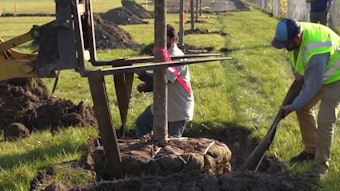
Once the winter season ends and temperatures begin to warm up again, warm-season grasses including zoysiagass, St. Augustinegrass, bermudagrass, centipedegrass and others start to come out of winter dormancy. While these grasses green up, it’s not uncommon to notice patches of brown spots or damage that wasn’t visible when the turfgrass was uniformly dormant and off-color. This can sometimes be an indication of turfgrass disease.
First, it’s important to note that although disease outbreaks can technically happen at any time of the year, warm-season turfgrass diseases typically become active during the spring and fall months while most cool-season grasses like fescue, ryegrass, bentgrass and bluegrass are impacted by diseases in the summer.
Having the basic knowledge about turfgrass diseases can be helpful in preventing and treating them appropriately.
About turfgrass disease
Any type of disease needs three things to spread and be present, also known as the disease triangle: a host, a pathogen and the ideal environmental conditions. The turfgrass is already a potential host. Pathogens that cause disease outbreaks are always in the grass, thatch layer, soil, etc., but these pathogens will often lie dormant until suitable weather conditions trigger them to spread. Therefore, weather plays a major role in disease outbreaks.
Although turfgrass diseases can take over lawns at any time of the year, the spring and fall seasons are two transitional periods between the hottest and coldest times of the year. When these transitional periods happen, temperatures are either rising or falling. The change in weather conditions that aren’t overly hot or cold combined with humidity, excessive irrigation and nitrogen inputs create opportune environments for disease outbreaks.
This is especially pertinent for warm-season grasses. Turfgrasses are more vulnerable to disease outbreaks if the grass is growing slowly, damaged or stressed. Cool-season grasses grow the slowest during the summer, while warm-season grasses grow the slowest as they go into dormancy during the fall or come out of dormancy in the spring.
Common spring turfgrass diseases
Diagnosing a specific turfgrass disease that’s present is important—but also difficult. Identifying a turfgrass disease will help the overall strategy for prevention and treatment. Although some professionals can look at a turfgrass disease and have a ballpark idea of which disease he or she may be dealing with, the best way to get a professional diagnosis is to send a sample off to a local land-grant university or extension office.
1. Anthracnose
When temperatures are warm and moist during the spring season, reddish-brown or brown spots may begin to appear. This may be a sign of a disease called anthracnose. These spots can sometimes be surrounded by a yellow halo, and over time, they’ll cause yellowing and death of the grass blade. Anthracnose mostly affects centipedegrass, but it has the potential to take over any warm-season grass.
Preventive and curative fungicides should contain one or more of the following active ingredients: azoxystrobin, chlorothalonil, fenarimol, fludioxonil, metconazole, myclobutanil, propiconazole, thiophanate methyl, triadimefon, trifloxystrobin or triticonazole.
2. Large patch
Large patch is a more common turfgrass disease that can affect all warm-season grasses. Although it’s often spotted in the spring as turfgrass comes out of winter dormancy, it takes over the grass during the fall—it’s just difficult to spot because most of the grass is uniformly dormant and off-color.
Large patch can range from a few inches to several yards in size and takes the form of large circles of thin, damaged grass. However, large patch isn’t circular in all cases. It can also look like irregularly shaped patches of damaged spots. In either scenario, it usually produces a bronze-colored border where the healthy grass and affected grass connect.
Fungicides should contain one or more of the following active ingredients: azoxystrobin, chlorothalonil, fludioxonil, flutolanil, iprodione, mancozeb, metconazole, myclobutanil, polyoxin D, propiconazole, pyraclostrobin, thiophanate-methyl, thiram, triadimefon, trifloxystrobin, triticonazole or vinclozolin.
3. Spring dead spot
Spring dead spot is another common warm-season turfgrass disease that demonstrates symptoms in the spring—hence, its name, “spring dead spot”—but takes hold of the grass during the fall. It can affect a number of turfgrasses, but it’s most commonly diagnosed in bermudagrass.
Signs of spring dead spot are bleached, sunken, circular patches that range between a few centimeters wide to larger patches on a lawn.
When searching for the best disease control for spring dead spot, there are many options to consider. For best results, consider using one or more of the following active ingredients: azoxystrobin, propiconazole, chlorothalonil, iprodione, thiophanate methyl, tebuconazole, fluoxastrobin, isofetamid, mefentrifluconazole, penthiopyrad, prothioconazole and pydiflumetofen.
4. Gray leaf spot
Gray leaf spot can look different from some of the other turfgrass diseases as it creates oblong spots on the leaf blades. These spots typically have a tan color with a darker ring around the border of it. Gray leaf spot is found when temperatures range between 77 to 86 degrees Fahrenheit and during rainy, humid periods.
The most affected turfgrass with gray leaf spot is St. Augustinegrass, but it can also infect fescue, bermudagrass, centipedegrass and ryegrass.
Fungicides with azoxystrobin, pyraclostrobin, fluoxastrobin, thiophanate methyl, propiconazole or myclobutanil are effective for prevention and treatment.
5. Rust
Rust has light yellow to orange spots on individual grass blades. The light yellow spots appear during the early phases of the infection. These spots later turn into an orange color that runs alongside grass blade veins in the later stages. The orange spots should rub off when touched.
The most affected grasses for this disease are zoysiagrass and St. Augustinegrass. The disease takes hold of the turfgrass from late fall to early spring and usually shows up when temperatures begin to warm up again.
Fungicides with the active ingredient azoxystrobin, mancozeb, mancozeb plus copper hydroxide, metconazole, myclobutanil, propiconazole, pyraclostrobin, triadimefon, trifloxystrobin and triticonazole are effective for prevention and treatment.
As with any fungicide, lawn care operators should be sure to read and follow product labels thoroughly.





























